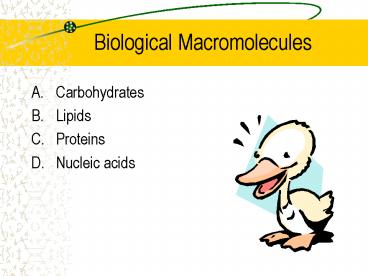Biological Macromolecules - PowerPoint PPT Presentation
1 / 16
Title:
Biological Macromolecules
Description:
Composed of chains of amino acids ... Each different protein has its own order, or 'sequence,' of amino acids ... Primary structure: amino acid sequence ... – PowerPoint PPT presentation
Number of Views:56
Avg rating:3.0/5.0
Title: Biological Macromolecules
1
Biological Macromolecules
- Carbohydrates
- Lipids
- Proteins
- Nucleic acids
2
A. Carbohydrates
- General properties
- Composed mostly of carbon, hydrogen, and oxygen
- Large number of OH groups attached to the
carbons - Functions
- Energy source for living cells
- Certain structural components of cells
3
A. Carbohydrates
- Monosaccharides
- Simple sugars
- Monomer unit of carbohydrate group
- Examples glucose, fructose
- Disaccharides
- Composed of two monosaccharide units joined
together - Examples sucrose, lactose
- Polysaccharides
- Composed of multiple monosaccharide units (100s
1000s) - Examples starch, glycogen, cellulose
4
B. Lipids
- General properties
- Biological compounds with hydrophobic components
in their molecular structures - Functions
- Energy storage
- Structural components
- Glycerides
- A major class of lipid
- Composed of a glycerol molecule attached to one,
two, or three fatty acid molecules
5
B. Lipids
- Generalized structure of a triglyceride
6
B. Lipids
- Fatty acid saturation
- Fatty acids with greater saturation have fewer
CC double bonds Have higher melting points - Fatty acids with less saturation have more CC
double bonds Have lower melting points
7
B. Lipids
- Phospholipids
- A lipid molecule (for example, a diglyceride)
with a hydrophilic group attached via a phosphate
linkage - Found in membrane structure (details later in
course) - Other lipids
- Sterols cholesterol and steroid hormones
- Waxes
8
C. Proteins
- General properties
- Composed of chains of amino acids
- There are 20 different amino acids, each with
distinctive chemical properties - A protein molecule may contain several hundred
amino acids - Each different protein has its own order, or
sequence, of amino acids - The correct sequence of amino acids is essential
for the proteins function
9
C. Proteins
- Functions
- Enzymes enzymes are biological catalysts that
control almost every reaction in living systems - Cellular recognition and communication
- Structural components of living cells
10
C. Proteins
- Amino acid structure
- To the central carbon atom, four things are
attached - Hydrogen atom
- Amino group
- Carboxylic acid group
- Side chain R group
- Twenty different R groups, with different
chemical properties
11
C. Proteins
- Peptides
- Chains of amino acids attached by peptide bonds
- May be named by number of amino acids dipeptide,
tripeptide, tetrapeptide, pentapeptide, etc.
Polypeptide
12
C. Proteins
- Protein
- A polypeptide chain with a specific biological
function - Most proteins have from about 50 up to several
hundred amino acids in their structure
13
C. Proteins
- Levels of protein structure
- Primary structure amino acid sequence
- Secondary structure localized folding of a chain
into regions of helix or sheet structure - Tertiary structure folding of a single
polypeptide chain into a three-dimensional
structure - Quaternary structure only in proteins with more
than one polypeptide chain Folding of more than
one chain together
14
D. Nucleic Acids
- General properties
- Composed of chains of nucleotides
- There are 4 different nucleotides
- A nucleic acid molecule may contain several
thousands or millions of nucleotides - Each nucleic acid molecule has its own order, or
sequence, of nucleotides - The correct sequence of nucleotides is essential
for the nucleic acids function
15
D. Nucleic Acids
- Overall function.
- The sequence of nucleotides in a nucleic acid
molecule serves as a blueprint to encode the
correct sequence of amino acids for a protein.
The code for a specific protein is called a
gene. - Deoxyribonucleic acid (DNA) DNA molecules
(chromosomes) serve as the master blueprint for
all of the cells proteins. The DNA molecules are
transmitted to offspring during reproduction. - Ribonucleic acid (RNA) RNA molecules serve as
working copies of the genes for the proteins
that the cell is making at any given time.
16
D. Nucleic Acids
- Nucleotide structure
- A nucleotide consists of
- Nitrogenous base
- Pentose sugar
- Phosphate group
- Nitrogenous bases
- Purines adenine guanine
- Pyrimidines cytosine, thymine (in DNA), uracil
(in RNA) - Pentose sugars
- Ribose (found in RNA)
- Deoxyribose (found in DNA)































